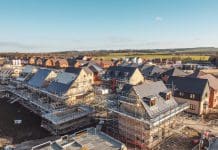Andrew Carpenter, chief executive of the Structural Timber Association and chair of BIM4Housing, discusses the cross-industry group’s mission of spreading the benefits of BIM in the housebuilding industry
Building Information Modelling (BIM) gets people and information working together effectively and efficiently through defined processes and technology. BIM was brought to wide industry attention in the UK government Construction Strategy published in 2011. Since then, the BIM Task Group has been developing standards and requirements to enable BIM adoption.
Take up of BIM is slowly but surely increasing, although there is still more BIM-related development work in the pipeline. This shouldn’t, however, prevent any organisation or individual from developing their own BIM awareness and capability. In fact, it’s important that the whole industry embraces the practice so that we can collectively look to optimise the benefits that BIM offers.
The emphasis is on the words ‘effective’ and ‘efficient’.
The construction industry is known for delivering projects late and over budget with the resulting assets often not quite working as they should. Adopting a BIM approach can bring predictability to a project, not just around capital delivery but operation too.
BIM can also help us to save both money and carbon by cutting out wasteful processes/activities and making more informed decisions at the right time.
The key BIM words to remember are: people, information, processes, technology, assets. A word to forget is ‘Building’. BIM applies to all built assets (bridges, roads, track etc.) not just buildings.
While some housebuilders and housing associations are starting to realise the benefits of BIM, others are taking a more cautious approach. The housing sector therefore needs to catch up.
Recent government and industry reports place a huge emphasis on digitalisation and productivity, which makes the need for the housing sector to adopt BIM very clear.
Mark Farmer’s review of the UK construction labour model, Modernise or Die, dated October 2016 says: “The acceleration of the wider digital revolution combined with a shrinking traditional construction workforce are two issues I would highlight as being critical to the future fortunes of the construction industry. One could argue that the ‘stars are aligning’ and now is the time to allow the opportunities from digitisation to offset the risks of continued reliance on labour-intensive techniques.”
The UK Industrial strategy published in December 2017 states: “Partnerships between the government and industry on sector-specific issues can create significant opportunities to boost productivity, employment, innovation and skills.
“We expect our groundbreaking Sector Deals to open significant opportunities for trade with international partners, and inward investment from abroad. A large number of industries have signalled their interest in developing a Sector Deal, and we have been working with many of them in recent months.
“In the White Paper, we have announced deals with the automotive, AI, construction and life sciences sectors. We look forward to opening negotiations with other sectors and announcing further deals that boost productivity in particular sectors in due course.”
BIM can play a vital role in improving productivity.
Dame Judith Hackitt’s interim report following the Grenfell Tower fire made five initial observations including that “the entire supply chain must play a part in preventing further tragedies”.
Dame Judith has also urged all parties – including the construction industry, building owners, regulators and government – to collaborate to remedy the many problems identified.
Speaking to BBC Radio 4’s Today programme, she said that both the regulations and the people enforcing them must take a share of the responsibility for shortcomings in fire safety in the built environment. The best way to ensure the entire supply chain is collaborating is to use BIM.
BIM4Housing is a cross-industry group open to all organisations involved in the design, construction, management and delivery of housing, both private and affordable. Membership of BIM4Housing is reflective of the sector, involving clients, contractors, consultants, suppliers, subcontractors and other interested bodies.
The Mission: To assist the building of more and better homes through digitalisation by supporting organisations in the housing sector with the adoption of Building Information Modelling.
Objectives
- To identify areas where there are unresolved development issues for BIM in the housing industry and drive their resolution.
- To encourage all industry parties to work more collaboratively together, using BIM as the vehicle to improve how interested organisations contribute, interface and take advantage of the benefits offered throughout the process.
- To liaise with BIM4 organisations in other sectors where cross-over, integration or information standardisation is required (eg BIM4FM, BIM4Manufacturing) either directly or through the broader BIM4Communities group.
- To build an evidence base (case studies, pilot projects etc.) and make it accessible to all.
- To spread knowledge and awareness of BIM standards, information, up-skilling requirements and best practice across the housebuilding industry through events and training.
- To liaise with BIM4Housing organisations in other countries to swap best practice and ensure international standardisation (eg Norwegian BIM Association).
Andrew Carpenter
Chief Executive
Structural Timber Association
Twitter: @BIM4Housing














